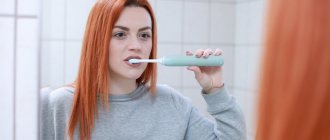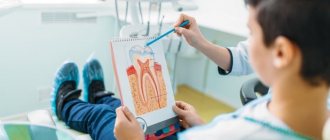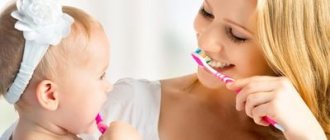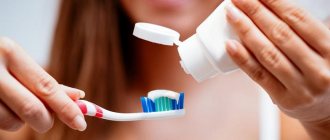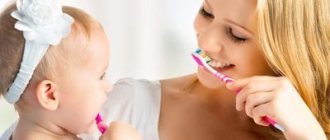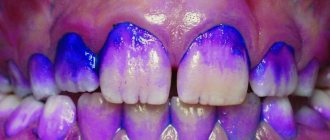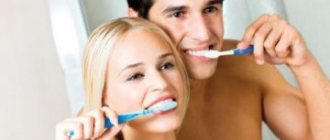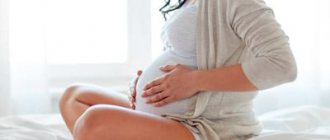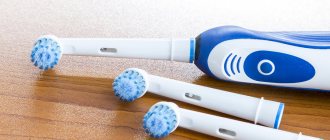Why brush your teeth?
You need to learn how to care for your mouth from early childhood. Of course, children 8–9 months old (the time the first tooth erupts) are not able to do this on their own. Parents should show their concern here.
Plaque on the surface of the enamel is an accumulation of large amounts of tiny food debris. If oral care is not taken on time, plaque increases. Combining with saliva, it mineralizes and becomes a stone that cannot be removed only with a brush. Important: the stone causes caries, periodontitis and other diseases. Caries is a trigger that essentially causes a chain reaction.
Caries and periodontitis
The structure of enamel is naturally porous and rough. Plaque on the surface fills the pores, causing inflammation. This is caries. If no measures are taken and prevention is not carried out, the disease spreads deeper. Over time, the inflammatory process spreads to the gums and roots.
Periodontium is the tissue surrounding the root of the tooth. It fixes it in the bone structure of the jaw. Inflammation in this area leads to the formation of a cyst.
Periodontitis
Destruction of the supporting apparatus of the tooth. At the same time, the gum gradually moves back and a pocket appears. This is where food debris accumulates. It is impossible to remove them yourself. Against this background, the gums swell, begin to bleed, and become sensitive during chewing. Purulent formations may appear in the pocket. Untimely treatment leads to loosening, displacement, and loss of teeth.
Important! Periodontitis is the second most common disease after caries. According to WHO, this pathology is diagnosed in 75% of children and 93% of adults.
Periodontal disease
According to statistics, out of 10 patients, periodontal disease is observed in 6 people. The disease is characterized by impaired blood supply to tissues. This leads to their degeneration and exposure of the neck of the tooth. The gums gradually rise above each other. At the same time, they do not turn red, do not swell, do not bleed, but simply slowly collapse.
Usually the disease affects both jaws at once.
Tooth loss
It needs to be prevented from early childhood. Parents do not always think about the consequences of premature tooth loss in their child. The thinking of some fathers and mothers is as follows: why treat caries of children’s teeth, because they are baby teeth and will soon fall out. This is a big misconception. By affecting baby teeth, caries leads to their premature loss.
Nature intended that the permanent tooth should replace the milk tooth, pushing it out. This order is a normal process. With premature loss, physiology is disrupted, which leads to improper eruption, crooked teeth and changes in bite. Such transformations entail many problems - impaired diction, deformation of facial features, gastrointestinal diseases. Adults experience the same problems when their teeth fall out.
Gastrointestinal diseases
Incorrect bite and lack of proper number of teeth affect the process of grinding food. Insufficiently chewed food ends up in the stomach, which finds it difficult to digest such food. As a result, gastric juice, which contains hydrochloric acid, is released abundantly. A large amount of it irritates the walls of the stomach. Over time, they become inflamed and gastritis develops. In case of untimely treatment, the pattern of disease development is probably known to everyone: gastritis - ulcer - oncology. And it is not a fact that the inflammatory process will not reach the duodenum or intestines.
Chronic pathologies
It would seem, what is a raid? A small buildup on the enamel surface that can be removed with a brush. But many pathogenic bacteria live in this area. If you do not clean the oral cavity, bacteria can migrate through the bloodstream (especially if the integrity of the gum tissue is damaged), move to the tonsils, and into the sinus area. This way the infection can reach any organ.
Think about the numbers! Out of 10 children with early caries, 9 suffer from chronic diseases of the respiratory and ENT organs! According to statistics, caries in childhood causes the development of a chronic form of sinusitis and tonsillitis.
A migrating infection can cause meningitis and provoke encephalitis. Diseases are difficult to treat, their consequences are terrible - dementia, disability.
In medical practice, there are known cases of death from sepsis. The cause is a bacterial infection that first caused tooth decay and then entered the bloodstream and caused sepsis. This advanced disease and its untimely treatment leads to death.
Psychological problems
In childhood, malocclusion becomes the result of crowded teeth, changes in facial features, and impaired diction. Often children feel awkward and begin to develop complexes. In the future, insecure people, already adults, cannot arrange their personal lives. In most cases, the lack of a smile is due to embarrassment and reluctance to talk again.
Psychologists say that in 15% of cases, alcoholism, drug addiction and teenage suicide are associated with complexes about appearance. 10% of them relate specifically to impaired diction and a deformed face due to malocclusion.a
So, caries caused by plaque can cause a lot of negative consequences. This can be avoided by maintaining oral hygiene and paying due attention to your health.
Is it true that dentists don’t want to teach us how to brush our teeth?
It may seem that the dentist has a vested interest in you brushing your teeth incorrectly.
Because if you teach it correctly, you won’t come back with caries or without a tooth at all. There are two exceptions:
- Hygienists who want to help the patient. This is either an ordinary human desire to do well, or the basis of the clinic’s work: good service is noticeable, and such a clinic is trusted much more (that is, they return much more often, and if a patient has been with the clinic for 10 years, then sooner or later he will statistically need expensive services) .
- And manufacturers of paste brushes and irrigators understand that the right set of consumables and instruments in the patient’s hands brings them quite a lot, so they try to train people in the correct processes, including through clinic hygienists.
We created the clinic as a way to make money at the cutting edge of applied science, but very quickly clients began telling their friends about us as one of the most caring dentistry in Moscow.
We were counting on “the most technically advanced”, but that was also nothing. I hope that “the most caring” contains my contribution, because I explain in great detail and detail how to avoid getting into the chair next time. And with me, you can practice brushing your teeth separately from the appointment: a hygiene lesson lasts 40–60 minutes, and the price includes the necessary set of brushes and brushes. PS If you come to our clinics, then say that you are from Habr, there will be a 5% discount.
How often should you brush your teeth?
Dentists recommend caring for your oral cavity 2 times a day (morning and evening). But the hygiene procedure does not end there. To prevent the development of caries, it is necessary to rinse your mouth after every meal. It doesn’t matter whether a person ate an apple, cracked seeds, or had a full lunch.
Intensive rinsing removes harmful bacteria and stuck food pieces. It is, of course, advisable to use special foams or rinses. You can make a solution of salt and soda (1 tsp per 0.5 liter of water). But if this is not possible, then at least use a floss and rinse your mouth with water.
Let's figure out whether it is possible to maintain oral hygiene when there is no toothbrush
The website of travel products manufacturer Minimus reports that 18% of travelers surveyed admitted that they often forget to take a toothbrush with them when traveling. It's even worse when you're late to your destination and can't get to the store to buy personal care products, but the hotel you're staying at doesn't offer them to guests.
In general, what to do if you hate going to bed with unbrushed teeth and literally feel like heaven all the bacteria that have accumulated during the day? Plus bad breath, harmful bacteria on the teeth, gums and tongue.
We offer you several ways to maintain oral hygiene without a toothbrush.
see also
15 cheap tips for travelers
How to choose a toothbrush
Not only is the correct cleaning technique important, but also the brush. When choosing a product, you need to navigate their diversity:
- Very soft brushes designed for children. This type is chosen for children over 5 years old, as well as people diagnosed with periodontitis. It is recommended that children under 2 years old brush their teeth with special silicone fingertips.
- Medium bristles hardness. Recommended for teenagers over 12 years old.
- Hard brushes. Can only be used after consulting a doctor. Excessive hardness causes enamel destruction. Recommended for coffee lovers, smokers, and people with increased stone formation. But such brushes can only be used by those who have strong enamel and a healthy oral cavity.
- Very hard brush. We are talking about brushes used in cases where bridges and braces are installed.
- Electric brushes. According to dentists, they are best for removing soft deposits. In addition, there is no need to make additional movements during cleaning. It is enough to slowly move the device over the surface of the teeth, and the electric brush will do the rest itself. But if the gum tissue is weak, then such a procedure can cause injury.
- Ultrasonic brushes. Does not damage gums. Approved for use for diseases of the oral cavity, installed braces or implants. Ultrasound cleans exposed surfaces and removes bacteria at a depth of 5 mm under the gums.
- Working head size. Preference should be given to products with small working heads. In this way, soft tissue injury can be prevented.
Pay attention to the hardness level markings. Responsible manufacturers always indicate it on the packaging:
- sensitive – very soft brushes;
- soft – soft;
- medium – brushes with medium hardness;
- hard – very hard;
- extra-hard – special brushes that remove large amounts of plaque and are intended for people with installed restoration structures.
An important rule: you need to change the brush every 3 months.
How to train
Accustoming a two-year-old to daily hygiene procedures is not an easy task. Sometimes this takes months. Recommendations from experienced parents and Dr. Komarovsky help simplify and speed up this process.
- Set an example.
Brush your teeth with your baby in the morning and before bed, don’t be lazy to show what you can do yourself. Play Mirror. The baby will repeat your movements. Develop the habit of going to the bathroom as a family.
- Don't put psychological pressure on your child.
The main thing is to be patient. Do not shout, do not force, if the harmful little one is capricious today and refuses to open his mouth and clean himself. Negative experiences will not help you develop the necessary self-care skills. Sometimes the child needs to be persuaded to watch you, to provoke the desire to taste the paste.
- Use a calendar to brush your child's teeth.
Praise and reward your child for his efforts. Take the time to create a dental brushing calendar for your children. This could be whatman paper, a poster, a diagram. Using a colored felt-tip pen, draw hearts for a good day when the baby went to the bathroom on his own before bed, or a tear from the mother if he was capricious today.
Don't forget about small gifts and surprises.
- Create a fun dentist and patient game.
Involve toys, older sisters or brothers in the process. Let the baby clean the mouth of his beloved bear, and then himself. The role of a doctor will appeal to the young dentist.
- Compete.
Quality, not speed. Involve your family in the game. Give away prizes for the best cleaning. The little student should receive the reward first.
- Use fun accessories to brush your teeth.
This is a toy brush, with a head in the shape of a cartoon character, multi-colored cups, tubes of pastes. Going to the bathroom with your favorite teddy bear or princess is much more fun.
- Provide a choice of toothpaste and brushes for your toddler.
He can independently show in the store which hygiene item is best to purchase. Place several toothpastes for children with pleasant flavors in a glass. It is not necessary to clean your mouth with one product every day; change them according to your mood.
- Connect your imagination and magic.
Come up with a story, a poem about magic brushes or paste. Tell them that obedient and neat children receive surprises from fairies. Treat your baby with a piece of candy or a toy hidden under the pillow in the morning. Next time he will run to the bathroom with pleasure.
- Use educational cartoons.
Educational stories with cute fairy-tale characters motivate little ones to repeat the brush movements after their mother and take care of their health. Watch the cartoon several times, bring the video to kindergarten. It is unlikely that the baby will want to be like the boy who cries in the bathroom, stomps his feet, refusing to brush his teeth, and then suffers from pain and is forced to go to the doctor.
- Explain the consequences of poor hygiene.
It is better to use colorful pictures and photographs from the Internet. Images of incisors worn out by caries and microorganisms will stimulate the child. A lot of cartoons have been made on this topic, useful for still toothless children and adults.
- Keep time on an hourglass.
Visualization is the best teacher. The mythical 2-3 minutes are incomprehensible to the child, and the flowing sand shows how long it takes to brush your teeth. The baby himself controls the duration of the process.
- Visit the dentist.
Do this before the first dental problems arise. The trip should be positive, filled with positive emotions. The doctor will make a suggestion to the capricious ones about the need for oral hygiene and tell them how unpleasant it is to pull out a diseased incisor. The authority of the doctor will affect the child.
- Buy a jaw model.
Or make it yourself. Using a plastic model will make it easier for your baby to learn how to properly clean his mouth. Consider the layout in detail, conduct a training course, tell us how an uncleaned incisor is damaged, and what happens to it next.
Choosing a toothpaste
Almost all pastes are therapeutic and prophylactic. Serve for mechanical cleansing and help prevent caries, periodontitis, and periodontal disease. To do this, the composition includes various components that should be taken into account when choosing a care product:
- Fluorides and calcium. Included in the composition for the prevention of caries and restoration of enamel structure.
- Medicinal plants, essential oils, antiseptic substances (chlorhexidine, triclosan). Eliminate bleeding, swelling of the gums, remove plaque.
- Potassium, strontium, aminofluoride, hydroxyapatite. Reduce tissue sensitivity and relieve pain.
- Enzymes (papain) and antimicrobial substances (lysozyme, lactoferrin, lactoperoxidase). Added to whitening pastes to increase the effectiveness of plaque removal.
- Vitamin complex (A, E, C, B, carotoline). Improves metabolic processes, accelerates the healing of the mucous membrane.
You need to choose a paste depending on your existing dental problems. Don't get carried away with fluoride-containing toothpastes. If there is an excess of fluoride, fluorosis can develop. Therefore, fluoride-containing toothpastes are used no more than once a day.
Step-by-step instruction
Cleansing takes 3 minutes! Particular attention should be paid to hard-to-reach areas: gum line, interdental spaces.
Cleaning scheme:
- Wet the brush with warm water.
- Apply the paste in a thin strip to the brush.
- Start cleansing from the upper jaw. First, treat the outer molars and chewing teeth behind the cheeks.
- The direction of movement is from left to right. If you are left-handed, it is better to start on the right.
- The basic rule of the technique is to place the brush parallel to the gums.
- Do not press too hard on the brush.
- Movements are circular, brush each area for 10 seconds. During this time, make 10 movements with the brush.
- Then start brushing from the gums to the bottom edges.
- Next, treat the inner surfaces in the same way.
- Clean your tongue and inner cheeks.
- Rinse your mouth, changing the water 3 times.
Don’t forget to wash your brush and treat it with an antiseptic after each procedure.
Toothpicks and chewing gum
Dentists do not recommend using toothpicks at all. The wood from which they are made flakes when cleaned. The separated particles can remain between the teeth and, over time, begin to rot and cause inflammation. And also, while using a toothpick, you can injure your gums without even noticing it. Alternatively, use thread.
It is a mistaken belief that chewing gum will help get rid of plaque and stuck pieces of food. Yes, undoubtedly, some parts of the remaining food will stick to the gum. But during the chewing process, when the gums press against each other, these same particles can get stuck in the interdental space.
In addition, recently placed fillings that have not withstood prolonged exposure “like” to stick to chewing gum.
Chewing gum does not strengthen the gums; this happens in the process of uniform chewing, and not when squeezing the jaws in one place. Chewing gum is usually one-sided and can lead to muscle atrophy on the opposite side because it will not receive the stress it needs.
Another disadvantage is that constant chewing will lead to overload of the periodontium. Against this background, periodontitis and gingivitis can develop.
Chewing gum contains dyes and sweeteners. Do not forget that dye E131 (contained, for example, in Stimorol chewing gum) causes the formation of cancer cells, E171 – liver and kidney diseases.
To remove food debris after eating, it is better to rinse your mouth with water 2-3 times or use a mouthwash or foam.
Useful video
In this video, Dr. Komarovsky will tell you how and when you need to start teaching your child to brush his teeth on his own:
Oral care is an important component for dental health , so it is necessary to teach your child hygiene from an early age.
You should patiently explain to your child the importance of the procedure and talk about the consequences of neglecting your teeth.
Over time, the child will definitely begin to brush his teeth on his own, without persuasion or reminders.
How to properly brush teeth with braces
With braces installed, teeth must be brushed 3 times a day. Regardless of whether you have removable braces or not, cleaning should first be done in the standard way using a brush and paste.
A prerequisite for braces and veneers is the use of an irrigator. This device uses a thin stream of liquid under high pressure to efficiently clean the enamel, gum pockets and the space between the teeth from fresh and old plaque.
Improper brushing of teeth
Let's admit it, we brush our teeth automatically. And we often do it wrong: we clean them with movements left and right, sherk-sherk. With this method of cleaning, soft plaque is transferred from the surface of the teeth to the interdental spaces and becomes clogged there. As a result, there is a danger of gum damage and the appearance of a wedge-shaped defect, especially on protruding teeth. A wedge-shaped defect is a lesion of a tooth in the area of contact with the gum. It looks like a step that resembles a wedge. The dimensions can range from barely noticeable to complete chipping in the future.
See what happens when we brush our teeth across their growth:
How to properly brush your teeth with an electric brush?
The electric brush can make up to 25 thousand rotations per minute. Therefore, the cleansing procedure takes less time.
There are more powerful brushes, for example, from. They make up to 45 thousand rotations per minute.
The usage scheme is, in principle, standard. You don't need to strain or make any movements. She works on her own. The brush should be held parallel to the teeth, without pressing, and moved along the surface.
The procedure time is 1.5–2 minutes.
Dr. Zubastik recommends
After each procedure, rinse the brush. Do not store children's and adult teeth-cleaning devices in the same place - the infection can easily spread to neighboring hygiene products.
Interesting! Ancient people ate food given by nature itself, receiving a large amount of vitamins and a massage effect for the gums. They lived to old age, keeping all their teeth in excellent condition. Our ancestors ate rough, solid food and fruits without using a knife. According to anthropological researchers, ancient man did not know caries. The lack of teeth could only be a consequence of surviving and fighting the beast.
Tags: braces, toothbrush, toothpicks, teeth cleaning
About the author: Dr. Zubastik
Typically, a toothache begins to subside on the way to the clinic and finally goes away after 10 minutes of sitting in line to see the dentist.
- Related Posts
- Which irrigator is better: honest rating based on reviews 2019-2020
- 5 home care products for braces
- How to properly brush your teeth with an electric brush?
« Previous entry
How to care for baby teeth?
Children's first teeth are especially susceptible to pathogenic microorganisms, which, with insufficient hygiene, lead to carious enamel lesions and pulp inflammation
Care consists of wiping, using a special paste and brush that is suitable for the baby’s age.
Choosing a brush and toothpaste for your baby
The tooth enamel of a child under 1.5 years of age is the most fragile and delicate. Taking this into account, you need to find a conveniently shaped brush in children's stores or pharmacies with rubber edges, rounded and soft bristles and a cleaning surface length of no more than 1.5 cm. Manufacturers often indicate the recommended age of children (from 0 to 6 months, from 6 months to a year and etc.).
At the Profident Junior clinic you will find the right care and provide you with ]professional teeth cleaning in Odessa[/anchor]!
Instead of the first brush, you can use a silicone fingertip with raised protrusions, but babies often “taste” it, partially biting the parent’s finger with their incisors.
Considering that a child absorbs up to 70% of toothpaste with saliva, you need to pay attention to products with a special composition that is safe for entry into the gastrointestinal tract. According to pediatricians and pediatric dentists, “Weleda”, “Country of Fairy Tales”, “ROKS baby”, “Nenedent” are considered excellent options for the youngest (from 0 to 6 months and beyond).
Teethers
The safest and most effective way to alleviate the baby's condition is to use gel teethers, which must be cooled beforehand.
What types of teethers are there and how to choose them?
Today there are a lot of gel and plastic teethers and we want to help you with this difficult task.
Firstly, teethers must be safe - it is advisable that they be round in shape and not have additional protrusions that can be traumatic for the mouth and eyes. In addition, they should be comfortable for the baby himself. And lastly, teethers often have silicone protrusions that should be smooth and not too large.
You can also find plastic teethers in the form of a toothbrush. Please note that the silicone parts on the head should be located around the perimeter, should not be hard, or on one side, performing the function of a toothbrush.
Also pay attention to the limiters to avoid trauma to the oral cavity and deep penetration of this teether or the wide, ergonomic handle.


